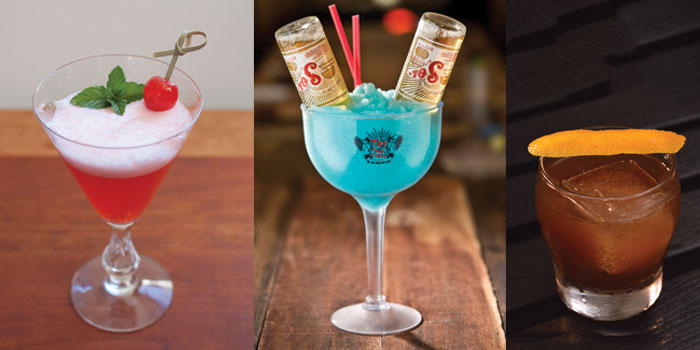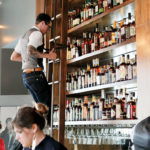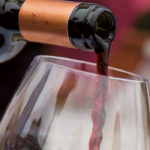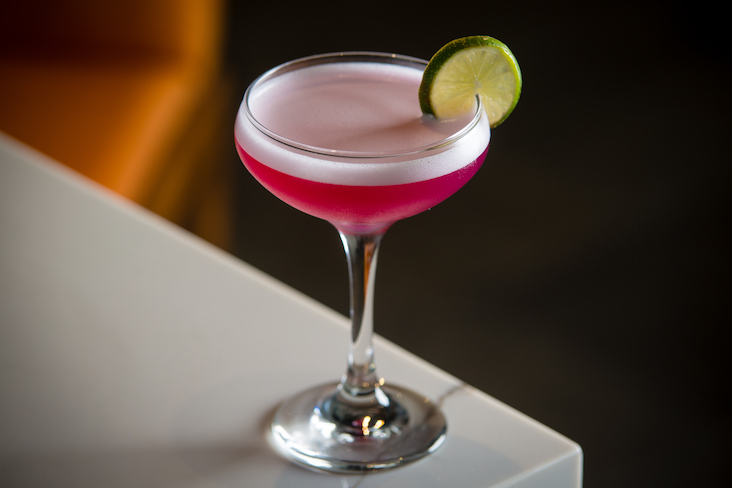Unique hoptails can brighten your beverage program
Although seldom seen just a few years ago, beer cocktails have now caught on in many markets. Mixing beer with some combination of spirits, syrups, sweeteners, bitters, spices, fruit, botanicals or even with other beers often results in effervescent and highly innovative beverages.
Some hardcore beer drinkers object to the idea of manipulating a beer that brewmasters have carefully crafted to be served as such. Likewise, there are cocktail drinkers who resist unconventional ingredients.
But beertails are no passing trend: Mixing beer with spirits and fruit or botanicals is a time-honored method of making drinks. People have been mixing beer into cocktails and other concoctions for centuries.
Combining spirits and ale was traditionally most popular during the holiday season. In Tasting Beer, expert Randy Mosher chronicles historical beer cocktails such as a Flip, a mix of strong ale, rum, sugar and spice that gets heated to just a simmer.
The concoction then gets caramelized in a spectacular fashion—it’s heated by the insertion of a red-hot fireplace poker. Eggnog can also be made with beer during the winter months.
Hoptails today typically incorporate different styles of beer and spirits. Mixologists are recognizing that beer, like any other bottle behind the bar, offers flavor and texture that can be tastefully employed to create something new.
Master Cicerone Mirella Amato devotes an entire section of her book, Beerology, to beer cocktails. “The whole idea behind adding beer to a cocktail is to use the character of that particular beer to contribute an added dimension,” Amato writes.
“The beer should therefore be detectable in the finished cocktail, either as a distinct note or as an indefinable component of the overall flavour profile.” Beer should be carefully used as an asset to a drink, not an afterthought, Amato stresses.
Creating signature beer cocktails
Hops, specialty malt and yeast produce the most noticeable flavors in beers. From smoky maltiness to piney bitterness and clovey yeast to funky sourness, you have an enormous range of flavors to work with.
To start playing with recipes, refer to a few guidelines that carry over from food and beverage pairing. When considering elements of the cocktail, such as which spirits and beer to marry, choose similar, complementary or contrasting flavors.
You want to achieve a balanced drink that’s neither cloying nor overly alcoholic. Take advantage of a certain beer’s strongest elements, which might be in the nose.
The Lion’s Share in San Diego makes a beertail called Hip Hops Diggity. Priced at $10, the drink mixes bourbon, Aperol, lemon and grapefruit, topped off with a foam made from local IPA The Apprentice, from Societe Brewing Co. The hoppy froth is pungent and enticing, the grapefruit note in the hops introduces citrus juice in the drink.
Complementary and contrasting flavors
Borgne Restaurant in New Orleans, a casual coastal eatery, offers a beer cocktail called Breaking Cane ($9). The drink matches like flavors—Canebrake, a local wheat ale from Parish Brewing Co. along with Sazerac rye, cane syrup and barbecue bitters.
Balancing the cocktail’s sweetness is essential, and the aroma from the peppery Sazerac and smokiness from the barbecue bitters do just that.
Bitter hops can be another way to achieve balance. At 320 Main, a chophouse and seafood restaurant in Seal Beach, CA, bartenders use Stone Brewing Co.’s IPA in the Detroiter beer cocktail ($12).
Thanks to a combination of Laird’s Bonded apple brandy, Cynar bitters, lemon juice and honey simple syrup with the IPA, the sweet and bitter flavors in this drink complement each other.
A beer cocktail can also be a study in contrasts. Barley, Wheat and Rye Social House is the bar counterpart to Metropolitan Farmer restaurant in Springfield, MO, an operation that values fresh ingredients and supports the local farming community.
The bar’s Rogue Sour ($13) incorporates Dark Horse Distillery’s Reunion rye, egg white, lemon juice, house-made vanilla simple syrup, Angostura orange bitters and a traditional Belgian sour beer called St. Louis Gueuze Fond Tradition. Spicy rye aromatics play against the beer’s puckering sour-apple flavor to make a dynamic contrast, while the emulsifying egg white smoothes out the texture of this elegant drink.
Seasonal and celebratory beertails
Many bars and restaurants offer beer cocktails year-round, while others develop them as specials to highlight the seasons. Alla Spina in Philadelphia, an Italian take on the gastropub concept (the name translates to “from the tap”,) offers several seasonal beer cocktails.
For example, the pub’s Fall Sangria ($8), made with sangiovese wine, Allagash White beer, applejack brandy and blueberries, helps capture the harvest spirit.
The Fade to Black cocktail from Mexican concept Mayahuel in New York takes the chill off in winter. This distinctive drink ($15) brings mezcal, Jamaican rum, Ramazzotti, mole bitters, whole egg and Negra Modelo beer together to offer an exotic counterpart to the traditional seasonal flavors of maple and baking spices.
Come spring, consumers delight in fresh botanical notes. Try for something mild enough to ease palates out of the deep flavors of hibernation, but bright enough to arouse the senses.
The Hop and Vine in Portland, OR, accomplishes that awakening with its Sidekick cocktail ($8). Botanical gin, sweet, herbal Galliano, Harlequin orange liqueur, cucumber, lemon and West Coast IPA induce sunny spirits even in the Pacific Northwest.
Beer cocktails can really shine in summer. The Pub resort and casino offers a Belgian Mojito ($12). It uses typical Mojito ingredients such as Bacardi Superior rum, fresh mint and lime, but tops it off with Matilda, a Belgian-style beer from Goose Island Brewing Co. Tropical fruit aromas from the hops and spice from the yeast play off the mint and lime, making the Mojito wildly fragrant.
Tacos & Tequila (T&T) at the Luxor Hotel & Casino in Las Vegas has a signature frozen cocktail called the Chonga. Priced at $20, it’s served in a 42-oz. cup filled with the guest’s choice of frozen Margarita, Strawberry Daiquiri, Coral Crush, Pina Colada, Watermelon or Pink Lemonade. The drink is then finished with tequila, vodka or rum, and topped off with two upside-down 7-oz. minis of Sol beers.
Signature beer drinks can also promote holidays and special occasions. “We keep at least a couple of beer cocktails on our everyday menu, and I always try to do something fun with seasonal beers,” says Dylan Fox, bar manager/beverage coordinator for Barley, Wheat and Rye Social House.
For instance, he notes, “this past winter we did a cocktail called the Social House Breakfast, which included rye whiskey, orange juice, egg white, local coffee, and our local Mother’s Wintergrind Coffee Stout.”
Eureka!, a chain of burger, craft beer and whiskey restaurants in California, Texas and Washington, this past June offered a Father’s Day weekend hoptail called the Go Ask Your Mother. Priced at $12, the unique take on the Old Fashioned used Overholt rye whiskey, Corsair Triple Smoke whiskey, Angostura and orange bitters and a house-made simple syrup with smoked porter from Stone Brewing Co.
You can also create beer-based beverages to go with specific cuisine. Malai Kitchen in Dallas specializes in food from Southeast Asia. The restaurant’s Thai Shandy mixes Hayman’s Gin, lemongrass, Kaffir lime, ginger and lemon juice; it’s then topped with Thai-P-A, a medium-bodied IPA brewed with Thai herbs by Malai Kitchen owners Braden and Yasmin Wages.
A few helpful hints
Before developing a beer cocktail recipe, consider your audience and establishment. The suitable drink for a playful Las Vegas resort will likely not be a fit for a formal New Orleans restaurant.
You can start by substituting different beers for club soda and then experiment by using beer in simple syrup or foam. Pull from traditional techniques and recipes or add a 21st century twist.
Keep your options open when crafting beer cocktails, Fox advises. “If you have an idea, make it a reality—and of course, have fun with it.”
It’s also a good idea to work with a beer that can be served in small portions—from the tap or a 12-oz. bottle is ideal, since large-format bottles can lose carbonation and oxidize once opened.
And keep in mind that the price point of beertails should be within range of other cocktails on the menu. So an expensive combination of beer and spirits may prove unsustainable.
Beer cocktails are in a sweet spot in terms of popularity—not rare, but also not quite yet mainstream. Offering them as regular drink menu items or specials shows customers that your beverage program is on point and innovative.
“Beer cocktails add a whole other family of cocktails to our menu,” says Philip Ward, co-owner and beverage director at Mayahuel. “They offer something that many other places very often don’t.”
And if the cocktail enthusiast is truly an enthusiast, Ward says, “they tend to frequent bars where not just their thirst but their curiosity is satiated.”
Fox agrees. “Beer cocktails have contributed a nice diversity to our beverage program,” he says. “When someone approaches the bar and says, ‘I love beer, and want a cocktail, but I just don’t know what I like,’ it presents a nice bridge for the gap between a cocktail drinker and a beer drinker. Plus, they’re super fun to make.”
Erika Bolden is a freelance writer and Certified Beer Server. She is a frequent contributor to L.A. Weekly, West Coaster SoCal and All About Beer magazine.









